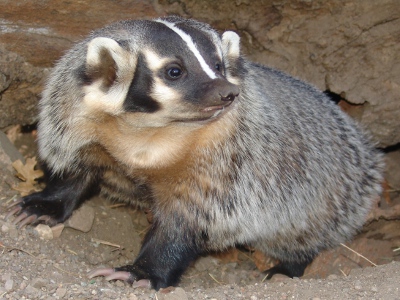Badger
Category: North American Mammals

Facts about Badgers, "Scientific name for Badger is Taxidea taxus". The Badger is one of the short-legged animals, which belongs to the Mustelidae family. The family of Badger also includes the polecats, otters, wolverines and weasels. The 11 varieties of badger are assembled in three subfamilies, such as Melinae, Mellivorinae and Taxideinae. The Melinae family consists of nine Eurasian badgers, the Mellivorinae consists of the Ratel or honey badger and the Taxideinae family includes the American badger. The Asiatic smell horrible badgers of the Mydaus type were previously included in Melinae family, but latest hereditary evidence indicates that these are, in fact, associates of the skunk family, inserting them into the taxonomic Mephitidae family. Badgers are largely found in Ireland, North America, the Great Britain, and most parts of Europe as far as the southern parts of Scandinavia. The Badger also reside in as far as the eastern parts of China and Japan.
Features of a Badger
A Badger has a somewhat short, plump body, with small legs for digging. They have a lengthened head resembling a weasel, with tiny ears. Their tails of these animals differ in length, according to the variety. The stink badger appears with an extremely small tail, whereas the tail of the ferret badger can have a length, ranging from 18 inches (45 cm) to 20 inches (50 cm), according to the age. The Badger have a gray-colored body, with the body length of 35 inches (89 cm), with a light-colored line from their head to tail. Their face appears in black color, with unique white color markings. Their legs are dark in color, with light-colored underbelly.
The European badger is one among the biggest badgers in the family, whereas the hog badger, the American badger and the honey badger are usually a bit lighter and smaller. The stink badgers are still smaller, and the ferret badgers are the smallest of all badgers in the family. Their body mass ranges from 20 pounds (9 kg) to 24 pounds (11 kg), with a few Eurasian badgers weigh 40 pounds (18 kg).
Badgers are included varieties in the genera Arctonyx, Meles, Mellivora and Taxidea. The lower jaws of a Badger are expressed in the upper through crosswise condyles tightly locked into extensive cavities of the head, so displacement of the jaw is all, but unfeasible. This allows the Badger to keep up its grip with the maximum tenacity, but limits the jaw movement to hinging shut and open, or descending between sides devoid of the twisting movement of the jaws of nearly all animals.
Diet of Badgers
The Badger breed is omnivorous, and it feeds on insects, earthworms, grubs, the eggs and the juvenile of earth-nesting birds. They also feed on small creatures, reptiles, amphibians and birds, in addition to fruit and roots.
Behavior of Badgers
The behavior of a Badger varies by family, but they usually shelter underground, existing in holes known as setts that may be extremely extensive. Some badgers are lonely, moving between homes, whereas some others are recognized to structure clans known as cetes. The size of a cete is uneven from two to fifteen badgers. They can gallop or run with a velocity of 25 (15 mph) to 30 kilometers per hour (18.5 mph). The Badgers are nocturnal. Occasionally, in North America, coyotes consume badgers and vice versa, but most of their communication appears to be neutral or mutual. Coyotes and American badgers have been observed hunting jointly in a supportive fashion.
Though the lifespan of the Badger depends upon their variety, usually, their average lifespan ranges from 24 years to 30 years.

 Back To Category North American Mammals
Back To Category North American Mammals